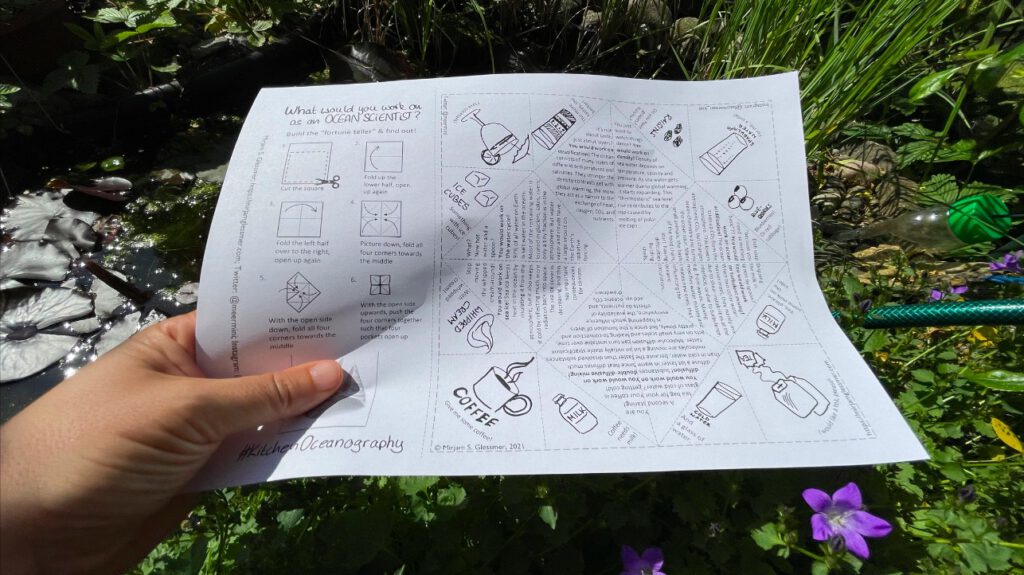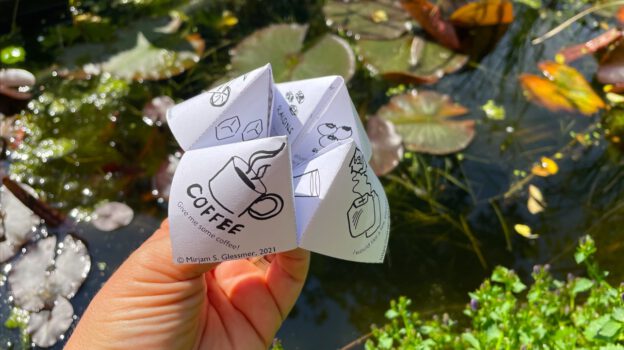I thought I would try a playful approach to ocean sciences for #WorldOceanDay on Tuesday. When I think back to my PhD and postdoc days, I could well imagine printing and building something like the “fortune teller” shown above, and then go visit some of my colleagues to show it to them. I would have thought it was fun then, and I still think so! So let’s see if people like it when I share it on Tuesday. For now, I would like to share my thought process and ask your advice in the end.
Goal, audience and message
The direct goal is to “condition” people to think about ocean sciences in their every day lives by installing an item they encounter every day as a trigger to make them think about ocean sciences. An indirect goal is that those people will then act as multiplyers to their friends and family.
The direct target audience for are people with an affinity for ocean sciences and some (or a lot of) backgound knowledge. My friends and colleagues, PhD students, master students, highschool teachers. They might then engage their networks in conversations.
The main message I am trying to convey is that you can enjoy the exploration of oceanic processes in your everyday life.
Implementation
In order to find a trigger in peoples everyday lives that we can use to connect to oceanography, I make use of the fact that most people have a go-to drink they like to order, and that in many of those drinks, there is a lot of oceanography to be discovered! So I am eliciting positive emotions when people think of their favourite beverages, raise curiosity by saying that those drinks can tell them something about their research interest, and then hopefully hold that curiosity in order to transfer it onto the hint of a related hands-on experiment with the drink they have in front of them (if not in that moment, than at least often) and a little bit of scientific input. The input is kept very general. It is not meant to give an overview, rather to show connections between the drink and the real world, and to give people key search terms if they wanted to investigate the topic further.
In previous versions (and before I tried whether the text would actually fit in the available space!), I provided a lot more input on the experiments that I am envisioning people would do with those drinks; on how and what to observe, and how to relate it to the ocean. But I ended up with a fairly minimal version: It does provide ideas about what experiments to do (or so I tell myself), but there is definitely a lot of room for open inquiry!
I find it difficult to imagine measuring the impact of such a gimmick like the “fortune teller”, so here is where I would like to ask for your help. I want to share the “fortune teller” via my blog and social media for #WorldOceanDay on Tuesday. With it, I want to share a link to a short questionnaire (all answers are optional). I am planning to ask the questions below, and I would love your feedback and suggestions for how to do it better in order to understand the impact of the “fortune teller”! :)
Questionnaire
- Did you build the “fortune teller” or are planning on doing so within the next 24 hours? (y/n)
- Did you show the build version to someone or share the pdf with someone? (y/n)
- Did you already look at drinks through this new “lens” or are you planning to do so within the next 24 hours? (y/n)
- Are you now curious to look at other drinks than your favourite one through this new “lens”? (y/n)
- How else did you or are you intending to use the “fortune teller”? (open)
- Did you read through all the text? (y/n)
- What advice do you have for me to make the “fortune teller” more useful? (open)
- Where did you first encounter the “fortune teller”? (multiple choice: via Mirjam (blog, social media), social media in general, email, in the office, … open: other)
- Who are you? (open: age; identify as oceanographer; if not open: what else; student/early career/mid career/…)
- May I contact you to talk to you about the “fortune teller” in a little more detail? (open: contact details)
What do you think? I would love to hear from you! :)
(And since you are still reading, thank you for your interest and here is a link to a printable pdf. I would obviously love your feedback on that one, too! But please don’t share widely before Tuesday)

